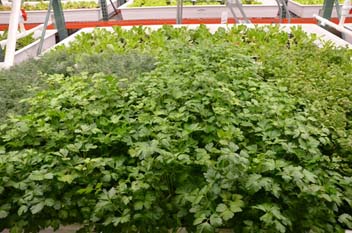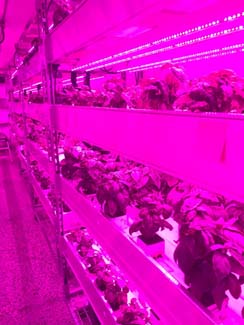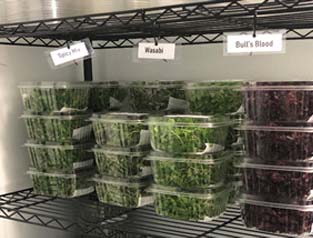Frequently Asked Questions
If you have a question, please do contact us through either our social media channels (at the top of the page) or the Ag Science Café. We look forward to hearing from you!
Are crops grown in indoor farms as nutritious as those grown in soil? What crops have been tested so far?
Generally, since soil and hydroponic nutrient solutions contain the same mineral-nutrient elements that all plants require, the mineral contents of soil-grown and hydroponic vegetables are similar. Since plants make their own vitamins and bioactive compounds, soil and hydroponic plants growing with adequate mineral nutrition should have similar vitamin tissue contents as well. Generally, fruits and vegetables have been most widely tested for nutrient content. By carefully controlling concentrations of specific mineral nutrients in hydroponic nutrient solutions, tissues of hydroponic vegetables can be intentionally enhanced in nutrient content and/or undesirable accumulations prevented for prescription nutritional content.
Do indoor farms and hydroponic systems need to be sterile?
Hydroponic production systems have a reputation for being sterile (i.e., without micro-organisms). Such is not the case, but it is important that plant pathogens (such as pythium root-rot) and other disease-causing bacteria, viruses, nematodes, fungi, and insects be excluded from soilless systems in indoor agriculture, so appropriate sanitation must be practiced for well-managed hydroponics. In fact, a rootzone microbiome in hydroponic systems is desirable for disease suppression. For organic hydroponic and aquaponic crops, rhizosphere microbials are very important, not only for preventing pathogen infestation, but also to promote mineralization of nutrients for plant uptake from organic substrates. In fact, inoculation of hydroponic systems with beneficial microbes is on the rise! There is considerable misunderstanding and confusion about running a "sterile” indoor farming operation, which is undesirable, and a "clean” operation, which is desirable
What risks or challenges can occur when crops (i.e., basil and lettuce) with different environmental and/or cultural responses are grown under the same conditions?
Some crops are compatible whereas others are not. Crops that have distinctly different temperature optima, responses to photoperiod and daily light integral, and/or mineral-nutritional requirements might be incompatible. Sub-optimal conditions could increase production time and reduce yield and quality of some crops. For example, optimum temperatures for basil and lettuce are distinctly different [by as much as 5 °C (9 °F)].
What criteria should I use to select sole-source lighting?
This is a complex question not only from the technical plant-lighting side, but also from the economic side for commercial growers. Characteristics of electric lighting will depend on the desired responses (i.e., yield, foliar pigmentation, morphology, flavor, or flowering) of the crop. Crops such as lettuce and microgreens can thrive under relatively low-light intensities, so they are good candidates for indoor production. However, the efficacy of sole-source lighting would be very important for high-light requiring and vining crops such as tomato. Today, most crops that can be grown indoors under sole-source lighting are limited to high-value and relatively low-light-tolerant transplants, microgreens, leafy greens, and culinary herbs with short production cycles so that production space can be turned over frequently.
Spectral composition of the light source is also important, and responses vary widely from crop to crop and potentially from one market to another. Mixtures of white and red LEDs have become popular for commercial production of leafy greens. However, when it is desirable to bring out leaf-pigmentation characteristics, such as anthocyanins (red and purple pigments) and other phytonutrient anti-oxidants in red leaf lettuce or purple basil, elevated blue light may be needed. The more sophisticated sole-source-lighting capabilities are, the higher the up-front capital costs will be, so growers need to carefully consider whether desired plant responses and economics will justify the costs of the sole-source-lighting technology investment. Such considerations also will drive crop choice, scope of the business operation, and desired crop attributes.
Are other countries utilizing indoor farming to grow food crops? If so, what crops are most commonly grown by this means?
Commercial indoor farms are operating in many countries worldwide. However, no countries or cities are currently using indoor farms as the major source of food crops. Microgreens, lettuce, and other leafy greens are the most common crops grown in indoor farms. Head-forming lettuces are also common (more common in other countries than in the U.S.).
What education/training programs currently exist that target the CEA workforce gaps?
Indoor farming specific training is very limited and is typically proprietary. However, Cornell University has been leading workforce development for the controlled-environment agriculture industry sector including indoor farms. The Japan Plant Factory Association has also been offering international training programs for indoor farming. In addition, some of the online courses offered by Michigan State University’s
College of Knowledge the University of Florida’s
Greenhouse Training, and the
GLASE consortium are relevant to indoor farming. There are also science- and engineering-based books on indoor production, such as Plant Factory (2nd edition) published by Elsevier.
What pests and pathogens pose the greatest financial impact to the production of crops in indoor farms? How is control maintained?
Environmental conditions in indoor farms are good for plant growth as well as some common horticulture pests (arthropods) including aphids, fungus gnats, thrips, whiteflies, and spider mites. Common plant pathogens include powdery mildew, downy mildew, and pythium root rot. If the entry points are not adequately monitored and controlled, young plants and workers can introduce pests. Human access in the production room should be minimized and workers need to take strict hygiene measures to ensure they are not introducing pests and pathogens. For example, installing air showers, wearing lab coats, washing hands, and sanitizing feet at the entrance to the production room is recommended.
What is the recommended plant density for lettuce and basil?
For head-forming lettuces, final plant density is typically between 3 to 5 plants per square foot (30-45 plants per square meter). For mini-head lettuces or basil plants, the plant density can be 3-4 times greater. Typically, young seedlings are initially grown at a much higher densities and respaced to the final plant density towards the middle of the production cycle. This practice is important for space utilization and to reduce energy costs.
Are consumers willing to pay more for local indoor leafy greens?
Potentially. Current consumer trends align very well with the attributes offered for indoor leafy greens. When ideally produced, indoor leafy greens are likely to provide improvements in the following consumer-preferred attributes: taste, freshness, safety, pesticide-free, organic, nutritional value, shelf life, traceability, reduced potential for food borne illness, and appearance (size, color, and lack of blemishes). Also, since indoor farms can be located close to consumers, it is possible to produce leafy greens locally. Furthermore, high-quality, consistent, year-round supply is one of the greatest advantages of growing leafy greens in indoor farms.
Given all the potential advantages of locally grown indoor leafy greens, consumers may be willing to pay more. The question remains how to signal the consumer that the leafy greens are from indoor farms and why that is to their advantage. Packaging, labelling, and consumer education are important because (1) consumers may not be aware of indoor production and its advantages, or (2) consumers may have attitudes that certain indoor farming practices are not "natural” (e.g., using soil-less media rather than soil or electric lighting rather than sunlight).

What are the largest capital and operational costs for indoor farming?
Capital expenditures (CapEx) or costs include land, building(s), and equipment. Equipment in most instances is likely to be the largest cost, particularly when automated systems are used. This includes materials and installation costs to assure (1) separation of the indoor growing area from the outside environment, (2) delivery and utilization of all nutrients, (3) sole-source lighting systems, environment control, and HVAC, (4) trays, racks, and related infrastructure for growing plants indoors, and (5) harvesting and packaging equipment for final preparation of products for shipping and sales.
Operational expenditures (OpEx) or costs include energy, labor, plants (i.e., seeds or young plants), packaging materials, water, nutrients, administration, marketing, production, and finance. Energy and labor are often two of the top three operational costs. In addition, depreciation (recognition of the consumption of capital across time) is often among the top three costs due to the significantly high capital investment for production. The distribution of operational costs can vary according to the level of automation and by geographic location. In Japanese indoor farms, electricity accounts for 21%, depreciation for 21%, and labor for 28% (
Kozai and Niu, 2020). In the European context, electricity makes up 28% of operational costs, followed by labor with 26% and depreciation at 23% (
Zeidler and Schubert, 2017). Numbers for U.S. operations are not yet available for comparison.
Does an indoor farm have to be large in order to be profitable? Are there savings in economies of scale?

As the industry matures, there will likely be two sizes of indoor farms that can be profitable. One size can be referred to as boutique farms. These could specialize in high-value leafy greens that are targeting buyers with highly demanding tastes and product requirements. Direct-to-consumer and direct-to-restaurant sales are the most likely distribution channels. The business model of boutique farms will focus on generating unique, high-value products with higher prices and margins to match. They can be smaller in size due to their specialized focus on niche and limited volume markets. The other type of farm could be large-volume farms focused on differentiated (not commodity) leafy greens products going into broad markets, especially grocery stores and high-volume food service. The business model of these farms will focus on achieving substantial economies of scale from indoor farming technology. They will likely be highly automated and capable of continuous and consistent production of high-volume leafy greens.
What are vulnerabilities that contribute to the failure of indoor farming operations?
Inability to achieve scale: Raising capital, which traditionally presents its own challenges, can be even more daunting when it proposes to implement an innovative cultivation system for producing leafy greens that challenges traditional farming. In the U.S., only about 10% of indoor farms were adopting large scale, capital-intensive operating systems by 2020. This scenario is albeit rapidly changing as the technology and its product are accepted by investors and consumers.
Inability to achieve a differentiated product: The technology of indoor farming allows for precise control of environmental conditions, water, and nutrients, and by doing so, consistently achieving increased phytonutrients and vitamins, appearance, and taste. The challenge for the industry, which is part of OptimIA’s research, is to understand the best combination of attributes for a differentiated product that attracts a sufficient price premium to justify corresponding investments in technology.
Inability to manage the highly complex growing environment to be efficient and effective: High-tech systems in indoor farms produce a plethora of detailed plant growing environmental data as well as traceable production and delivery systems, which bring opportunities for producing high quality produce, food safety control, and efficient production and distribution of fresh produce. However, their innovative nature also creates the challenge of sourcing qualified personnel to maintain control over such complex systems.
Inability to have the proper mix of labor and capital: Technology used in indoor farms is evolving at a very fast pace, offering a vast range of specific systems including water delivery, plant washing, and automated planting and harvesting equipment to mention a few. These innovative systems can promote efficiency in production but also require high capital investment. The challenge, which is part of OptimIA’s research, is to understand the impact of these automated systems, once tailored to marketable opportunities and desirable scale, on profitability in the short- and long-run to define best ratios of automation to labor and capital investment.
What percentage of total operating costs does energy account for an indoor farm?
Energy is one of the largest operating costs of indoor farming, but the magnitude depends on the site-specific cost of electricity. Labor and depreciation of capital costs are the other two of the big three. The percentage of energy in the cost structure can vary widely based on the capital equipment adopted for the farm, local utility costs, and optimization of the inputs needed for leafy greens growth.
Agrilyst (2017) identified labor as the most significant operating cost in indoor agriculture around the world; representing 56% of operating costs. The survey determined that energy was the second largest operating cost, accounting for 12% and 25% of total annual operating expenditures of small farms large farms (10,000 sq. ft. or more), respectively, in which 81% of respondents were farms from the United Sates and 12% from Canada. In nominal values, an indoor small farm spends $3.45/sq. ft. and large farms spend on average $8.02/sq. ft., running an average photoperiod of 16 hours. In 2019, the CEA Global Census also ranked labor before energy costs but it did not provide a percentage of operational costs.
What crops are well suited to indoor farming?
Crops that are excellent candidates for indoor production usually have most or all of these characteristics:
- The production cycle is short
- The harvestable yield (the portion of the plant that is marketable) is high
- Plants have a compact growth habit
- There is year-round demand
- Production can be (semi-) automated
- The product is perishable
- Plants have a low to moderate light requirement
- The crop value is relatively high
Leafy greens and herbs are excellent candidate crops for indoor production because they fit many of these categories.
Here is an article with more information on this topic.
What crops are not well suited to indoor farming?
Crops that do not meet at least several of the characteristics listed above are usually not economically viable for indoor production. For example, corn has a long production cycle, a low harvestable yield, requires pollination, and occupies a lot of space, especially vertically. In addition, the economic value of a crop (an ear or bushel of corn) is relatively low.
How many hours a day should you run sole-source lighting?
The length of lighting depends on the crop grown, and whether its flowering is influenced by the lengths of the day and night (the photoperiod). For crops that are not influenced by the day-length (photoperiod), lighting can operate up to 20 to 24 hours per day. However, the number hours of lighting may be reduced for several reasons, including the desire to induce or inhibit flowering, or to avoid peak electricity charges. For leafy greens such as lettuce, lighting at a lower intensity for a longer period of time each day can increase growth more than lighting at a higher intensity for a shorter period of time. See this
research highlight for more details
Is carbon dioxide injection necessary in indoor production?
Carbon dioxide injection is particularly necessary when the plant growing area does not have enough ventilation to introduce fresh air from the outside. Otherwise, CO2 concentration will reach a very low level that limits plant photosynthesis even when light and temperature are optimized. In a growing area with limited ventilation, maintaining a higher CO2 concentration than that outdoors typically increases photosynthesis and therefore yield. Many indoor and greenhouse growers of vegetable crops enrich the atmosphere to 800 to 1200 ppm CO2. In many commercial situations, especially for larger farms, the increase in harvestable yield is worth the cost of CO2 injection.
What advantages do indoor farming provide over hydroponic greenhouse, high tunnel, or field production?
Indoor vertical farming offers many advantages over greenhouse, high tunnel, or open field production, including: precise control of temperature, light (light quality, intensity and duration), carbon dioxide, and humidity; increased quality and yield; predictable crop timing; year-round production; reduced water usage; increased food-safety and security; decreased pest and weed control pressure; and lack of exposure to climatic extremes such as drought, flooding, and low- and high-temperature stress.
What crops are recommended for a new indoor operation?
Generally, high-value crops such as leafy greens, herbs, and microgreens that require low to moderate light levels can be grown successfully in indoor farms. Also consider the length of the crop production cycle, the harvestable yield, plant height, local or regional market/ demand for the crop, perishability, crop compatibility, and if there is potential to add value to the crop by growing it indoors.
What is the typical time to harvest from seed sow for lettuce and basil?
Several environmental factors will influence the size and production time of crops including temperature, light intensity, quality and duration, and carbon dioxide concentration. Additionally, your market may dictate the size of plants that you need to achieve. The type of lettuce (i.e., butterhead or leaf) will also have an effect. Temperature has a strong influence on the rate of plant development, including the rate of germination, rooting, leaf unfolding, and flowering, with different crops having specific temperature ranges conducive for development.
Under optimum conditions, time to harvest from seed sow is often 4 to 6 weeks for lettuce and basil, respectively. Growers of baby greens may harvest plants after 18 to 24 days from seed sow. Basil can be harvested a couple of times from the same plant, and the time to the second cut is typically shorter (~2 weeks after the first cut).
Do the light-emitting diodes (LEDs) used in indoor farms pose any health risks to workers?
Traditional LEDs are generally considered safe; however, certain high-energy wavelengths used for crop production can pose harm to humans. For instance, if UV light is used for any part of the production to enhance crop quality attributes and managing crop disease or abnormalities, then direct exposure to UV light to workers should be avoided. Excessive eye exposure to bright light intensities, especially blue light, can damage eyes and thus, the use of protective shields or light filtering glasses is recommended. Some individuals can become nauseous if they work under sole-source lighting providing red and blue light. Therefore, the addition of white LEDs or use of filtering glasses can improve human vision and comfort.
What are some of the more challenging crops or crops to avoid for indoor production?
Generally, crops that require high-light intensities, have long production cycles, require manual pruning and harvesting, have a small harvestable index, and are not compact will be more challenging to grow indoors. This includes tall or vining crops such as tomatoes, peppers, and cucurbits. Other factors to consider when deciding which crops to grow indoors include the year-round local supply and demand, and prices and qualities of crops that are grown in the field, high tunnels, or greenhouses or are imported from other countries.
What factors must be co-optimized in indoor farms?
Various factors must be co-optimized together to help reduce costs, increase product value/quality attributes, and lead towards enhanced resource-use efficiency. Resource-use efficiency can be defined as the ratio of the produce yield or produce quality aspects as outputs to resources consumed as inputs (i.e., electrical energy, water, nutrients, CO2, and labor). Factors to consider for co-optimization include air temperature, humidity, vapor pressure deficit, daily light integral considering light intensity and photoperiod, light quality, CO2 concentration, air flow and distribution, and electrical conductivity (EC), pH, dissolved oxygen, and nutrient solution temperature from the root zone environment.
Does the increased cost of customizable lighting (ability to adjust wavelengths) justify the benefit of having the flexibility they allow?
This depends on how a wavelength-tunable lighting system will contribute to yield and crop quality attributes, as well as the cost and electrical efficiency of the lighting fixtures and control software. With customizable LED lighting, various plant light recipes can be tailored and controlled dynamically during crop growth stages to enhance color, phytonutrients, yield, and other quality attributes. Alternatively, different fixed-wavelength lighting fixtures in different locations of a vertical farm could allow plant exposure to different light spectra during a growing cycle.














